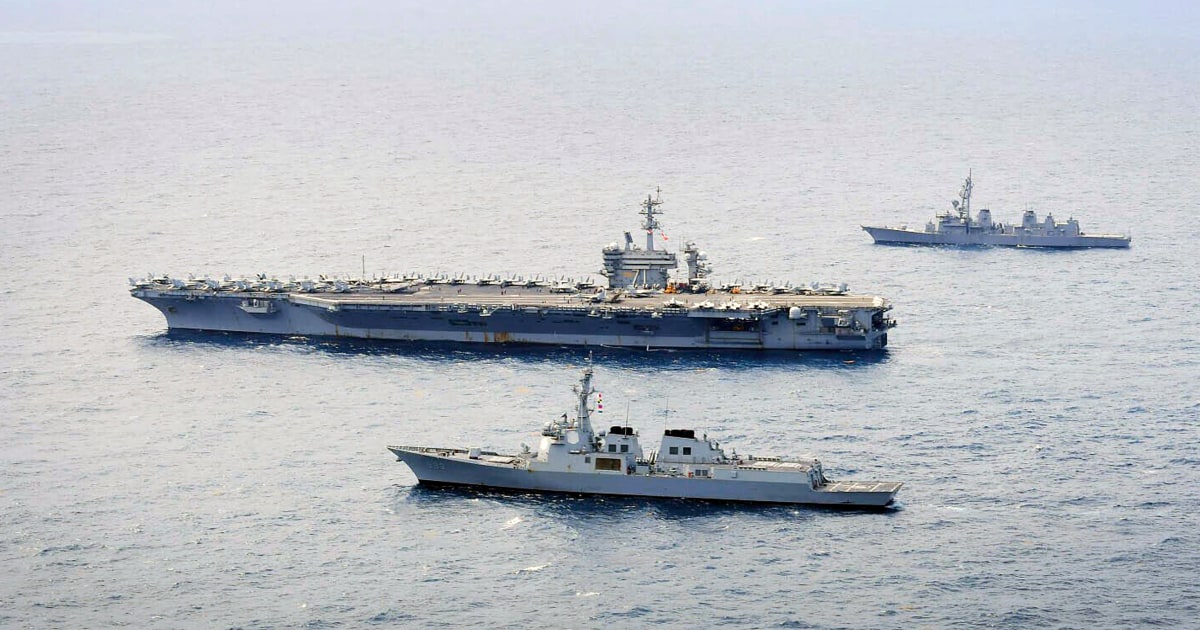ABOARD THE USS THEODORE ROOSEVELT — A U.S. carrier strike group led by the USS Theodore Roosevelt has held a three-day joint exercise with its allies Japan and South Korea as President Joe Biden meets for talks with leaders from Japan and the Philippines at the White House.
The dueling military and diplomatic maneuvers are meant to strengthen the partners’ solidarity in the face of China’s aggressive military actions in the region.
A number of U.S. and South Korean guided missile destroyers and a Japanese warship joined the April 10-12 drill in the disputed East China Sea, where worries about China territorial claims are rising. The Associated Press was one of several news organizations allowed a front-row look at the drills.
Rear Adm. Christopher Alexander, commander of Carrier Strike Group Nine, said the three nations conducted undersea warfare exercises, maritime interdiction operations, search and rescue drills and work focused on communication and data sharing. He told journalists Thursday on the Roosevelt that these drills would help improve communication among the United States and its allies and “better prepare us for a crisis in the region.”
F/A-18E Super Hornet combat jets took off from the carrier’s flight deck, which also had anti-submarine MH-60R Seahawk helicopters. Journalists were flown more than an hour from Kadena Air Base, the hub of U.S. Pacific air power. Kadena is on Japan’s southern island of Okinawa, which is home to about half of the 50,000 American troops stationed in Japan.
“It is a busy time; there is a lot going on in the world,” Alexander said. “The significance of this exercise is we have three like-minded countries, three like-minded navies that believe in peace, security and stability in the western Pacific.”
The participation of Japan and South Korea was another sign of improving ties between the sometimes wary neighbors. The two U.S. allies’ relationship has often been strained by the memory of Japan’s half-century colonization of the Korean Peninsula. Washington has been pressing them to cooperate so the three partners can better deal with threats from China and North Korea.
This week’s huge parliamentary election defeat of the governing party of South Korean President Yoon Suk Yeol, who has sought better relations with Japan, could constrain his Japan-friendly efforts, but experts believe ties will remain stable.
The latest naval exercise is part of Biden’s work to deepen security and diplomatic engagement with Indo-Pacific nations. Biden invited Japanese Prime Minister Fumio Kishida and Philippine President Ferdinand Marcos Jr. to the White House for their first trilateral talks Thursday, and has declared that the U.S. defense commitment to the Pacific allies is “ironclad.”
Tensions between China and the Philippines have risen over repeated clashes by the two nations’ coast guard vessels in the disputed South China Sea. Chinese coast guard ships also regularly approach disputed Japanese-controlled East China Sea islands near Taiwan.
Beijing has defended its operations in the South China Sea and blamed the U.S. for creating tensions. Chinese President Xi Jinping had a series of talks this week with senior officials from Vietnam, Russia and Taiwan.
The U.S.-Japan-South Korea naval exercises follow four-way drills held in the South China Sea, where Japan joined the United States, Australia and the Philippines. Participants carefully avoided mentioning China and said they were holding the exercises to safeguard a peaceful and stable Indo-Pacific.
An area of long-simmering disputes, the South China Sea serves as a key sea lane for global trade. Concerned governments include Vietnam, Malaysia, Indonesia, Brunei and Taiwan.











